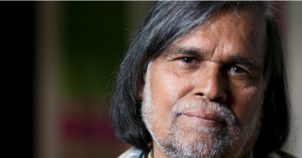
By Nick Meynen.
Two men coming all the way from the Indian jungle admired the most sacred site of London: St. Paul’s Cathedral. They checked the rock quality, deemed it perfect and asked for the London mining authorities. That day, an newspaper-ad showed a demolition crane smashing the St Paul’s Cathedral.
The point was to draw attention to men coming from London to the Indian jungle to check rocks and destroy the most sacred site of locals. Vedanta Resources, headquartered in London, wanted to exploit the Niyamgiri hills in India’s state of Odisha. These are filled with bauxite, the raw material for making aluminum. But according to the native Dongria Kondh, they are also filled with Gods.
This is of course comparing apples and oranges. In addition to being a main sacred site, the Niyamgiri Hills are also the source of water, food, medicine and fuel. The St Paul’s Cathedral has non of these life-sustaining qualities.
A 12 year long ordeal
Threats, heated village councils, referenda, campaigns, demonstrations, harassments and litigation until the Supreme Court: thousands of people lived on the edge for more than twelve difficult years. The iconic leader of social justice movements in India, Prafulla Samantara, who was born in a family of farmers, led this historic battle. In the end the Supreme Court affirmed the indigenous Dongria Kondh’s land rights and protected the Niyamgiri Hills.
Trouble started in 2003, when Vedanta Resources signed a contract with the Government of Odisha to construct a massive alumina refinery and coal thermal plant at Lanjigarh. The Ministry of Environment and Forests (MoEF) gave environmental clearance to the company on the basis of the company’s assertion that it would not divert forestland. But the alumina refinery project requires 3 million tones bauxite per annum and the location of the refinery was chosen because of the bauxite reserves under the forested and sacred Niyamgiri hills.
Soon, a village committee noted the lack of in-depth studies about impacts of such mine on the water regime, flora, fauna and on the Dongria Kondh tribes living at Niyamgiri Hills. They also pointed out that the area came under Schedule V of the Indian Constitution, which prohibits the transfer of tribal land to a non-tribal group. Furthermore, the report accused Vedanta of providing wrongful information and thereby circumventing the law. While the arguments continued in the Supreme Court, the company meanwhile continued with the construction of the refinery in 2006, causing the displacement of over a hundred tribal families. Then, the company proceeded to argue that the adjacent mine was essential to the refinery. It’s a well known procedure by major mining companies all over the world: put the cart before the horse and blackmail the state later, when you’re already in too deep.
A legal U-turn
In 2007, the Supreme Court granted permission to proceed with the mining, as long as they paid some extra damages to offset the negative externalities of the project. However, forest clearance was still pending and in 2010 a Committee argued that the local tribals should have the right to protect their rights under the Forest Rights Act. Finally in 2013, the Supreme Court ruled that the local inhabitants should decide if mining in Niyamgiri hills will affect their religious and cultural rights or not. Following this, the Odisha government drew a list of 12 affected villages in Rayagada and Kalahandi districts, to hold palli sabha (local referenda). The 12 villages unanimously voted to reject the mining project in the first ever environmental referendum in India. It appears that Vedanta has lost this battle, although neighbouring districts that hold bauxite deposits are now under pressure.
The Goldman Environmental Prize given to Prafulla Samantara on 24 April is a celebration of the courage, persistence and strength of so many people in the Global Environmental Justice movement, which is particularly strong in India. He is only one of the many inspirational people in the local and Indian chapter of this global movement. Many tears were shed before they arrived at this point.
What we can learn from this success story
This particular case has been studied in great detail by academics from the EnvJustice project, to better understand the controversies around putting a price on nature. It’s also part of our studies on the forms and formulas of the growing global environmental justice movement. The case stands out for several reasons. While all the hard ground work in India surely made most of the difference, it is also worthy to note the difference that the stunt in London also made. It was timed together with an annual shareholders meeting, in which Vedanta’s boss Anil Agarwal expressed a misplaced self-assurance about being able to mine the Niyamgiri hills. He literally said that the bauxite in the hills was predestined for Vedanta. The Church of England, however, did not exactly agree with this self-accaimed “divine blessing.” Following the actions of the activists in London, who aimed for St Paul’s Cathedral, the church sold their investments in Vedanta Resources. Mining multinationals are powerful, but they better not underestimate the power of the multinational resistance movement. This movement—and the courts—have proven to be stronger. Maybe the story of Prafulla Samantara and his movement can inspire all those fighting for environmental justice.

The project ENVJUSTICE has received funding from the European Research Council (ERC) under the European Union’s Horizon 2020 research and innovation programme (grant agreement No. 695446)